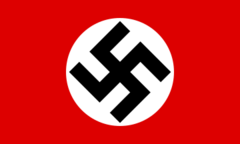Nazi Party: Difference between revisions
Harrystein (talk | contribs) m (→top: AWB: Stub replacement) |
RedParabola (talk | contribs) mNo edit summary |
||
| (5 intermediate revisions by 2 users not shown) | |||
| Line 1: | Line 1: | ||
The '''National Socialist German Workers' Party''' (German: ''Nationalsozialistische Deutsche Arbeiterpartei'') or '''Nazi Party''' was a [[fascist]] [[political party]] which ruled [[Germany]] from 1933 to 1945 under the ideology of [[Nazism]], an era known as [[Nazi Germany]]. Until 1933, the party contained | {{Infobox political party | ||
| name = National Socialist German Workers' Party | |||
| native_name = Nationalsozialistische Deutsche Arbeiterpartei | |||
| logo = NSDAP-logo.png | |||
| leader = [[Adolf Hitler]] | |||
| foundation = {{Start date|1920|02|24}} | |||
| ideology = [[Fascism]]<br>[[Nazism]] | |||
| abbreviation = NSDAP | |||
| dissolved = October 10, 1945 | |||
| position = [[Rightism|Extreme-right]] | |||
| flag = Flag of the NSDAP.png | |||
}} | |||
The '''National Socialist German Workers' Party''' (German: ''Nationalsozialistische Deutsche Arbeiterpartei;'' '''NSDAP''') or '''Nazi Party''' was a [[fascist]] [[political party]] which ruled [[Germany]] from 1933 to 1945 under the ideology of [[Nazism]], an era known as [[Nazi Germany]]. Until 1933, the party contained disparate [[Syncretic politics|syncretic]] elements such as Gregor Strasser and the vague anti-capitalist tenor of the ''Sturmabteilung'' street gang, and its founding constitution contained pseudo-socialist elements which were generally ignored under [[Hitler]]'s tenure. | |||
The party focused on a cult around [[Adolf Hitler]], but was not founded by the man. It arose out of the German Workers' Party,<ref group="note">German: ''Deutsche Arbeiterpartei''</ref> a short-lived proto-fascist party, which Hitler joined in 1919, quickly rising to the top of the party. In 1924 the party attempted a coup in Munich, known as the "Beer Hall Putsch", which ended in failure; Though the NSDAP party leadership was prosecuted for treason, because the [[Bourgeoisie|bourgeois]] ruling class of the Weimar Republic preferred anything to the perceived [[KPD|Communist]] threat, Hitler was able to use the court as a soapbox, also receiving a lax sentence of merely 9 months in prison.<ref group="note">The maximum sentence was a life imprisonment, and he was originally sentenced to 5 years in prison.</ref> | |||
Even with the sentence, the prison was highly relaxed, allowing ample time for the writing of [[Mein Kampf]].<ref>Wyllie, J. (2020). Nazi Wives: The Women at the Top of Hitler's Germany. St. Martin's Publishing Group.</ref> In the 1928 federal elections, the NSDAP did poorly, receiving only 2.63% of the vote, but swelled in the 1930 election, receiving 18.25%. In the 1932 election they received 37.3%, the highest out of all parties. In 1933 Hitler was appointed chancellor in an attempt by the bourgeois leadership of the [[Weimar Republic]] to "calm" his radicalism: this did not work. | |||
== References == | |||
{{reflist}} | |||
=== Notes === | |||
<references group="note" /> | |||
[[category:nazism]] | [[category:nazism]] | ||
[[category:world War II]]{{Party-stub}} | [[category:world War II]]{{Party-stub}} | ||
[[Category:Fascist parties]] | |||
[[Category:Nazi Germany]] | |||
Latest revision as of 16:52, 24 April 2024
National Socialist German Workers' Party Nationalsozialistische Deutsche Arbeiterpartei | |
|---|---|
 | |
| Abbreviation | NSDAP |
| Leader | Adolf Hitler |
| Founded | February 24, 1920 |
| Dissolved | October 10, 1945 |
| Ideology |
Fascism Nazism |
| Political position | Extreme-right |
| Party flag | |
 | |
The National Socialist German Workers' Party (German: Nationalsozialistische Deutsche Arbeiterpartei; NSDAP) or Nazi Party was a fascist political party which ruled Germany from 1933 to 1945 under the ideology of Nazism, an era known as Nazi Germany. Until 1933, the party contained disparate syncretic elements such as Gregor Strasser and the vague anti-capitalist tenor of the Sturmabteilung street gang, and its founding constitution contained pseudo-socialist elements which were generally ignored under Hitler's tenure. The party focused on a cult around Adolf Hitler, but was not founded by the man. It arose out of the German Workers' Party,[note 1] a short-lived proto-fascist party, which Hitler joined in 1919, quickly rising to the top of the party. In 1924 the party attempted a coup in Munich, known as the "Beer Hall Putsch", which ended in failure; Though the NSDAP party leadership was prosecuted for treason, because the bourgeois ruling class of the Weimar Republic preferred anything to the perceived Communist threat, Hitler was able to use the court as a soapbox, also receiving a lax sentence of merely 9 months in prison.[note 2]
Even with the sentence, the prison was highly relaxed, allowing ample time for the writing of Mein Kampf.[1] In the 1928 federal elections, the NSDAP did poorly, receiving only 2.63% of the vote, but swelled in the 1930 election, receiving 18.25%. In the 1932 election they received 37.3%, the highest out of all parties. In 1933 Hitler was appointed chancellor in an attempt by the bourgeois leadership of the Weimar Republic to "calm" his radicalism: this did not work.
References
- ↑ Wyllie, J. (2020). Nazi Wives: The Women at the Top of Hitler's Germany. St. Martin's Publishing Group.